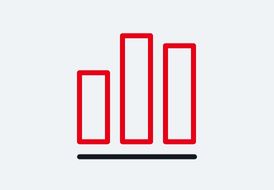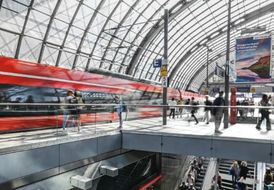Nature conservation Additional information
Responsibility for wildlife and plants
DB Group’s rail routes, buildings and spaces often provide a unique habitat for protected species. We develop eco-friendly solutions to offset any impact that our work has on the natural world. For the construction involved in the Bamberg hub expansion project, measures will be taken on approximately 33 ha of the Hauptsmoor forest, for example rewetting, forestry measures and species protection measures for sand lizards and bats. When dismantling buildings and facilities, we also provide suitable nesting areas, for example the multifunctional swallow tower, which provides space for other bird species and bats, as
well as for swallows. In addition, we are currently working on a research project of the German Center for Railway Traffic Research on further solutions to protect birds and small animals even better.
Bird protection measures
We recorded about 3,300 short-circuit events on overhead wires caused by animals in 2022. About 93% of them involved birds and about 7% involved small mammals (almost unchanged from previous year). To improve the situation, bird protection measures ∫ no. 33 are carried out on the insulators as part of the full overhead line inspection. Traction current lines in areas that have a high risk of bird collisions are also being made safe.
Insect Protection Act
More than 50 million honey bees ∫ no. 10 find their habitats on our land. For wild bees and other insects, structures known as arks are being set up in selected stations. Fifty beehives were also set up at our logistics locations in the Benelux countries and several bee boxes are used as nesting aids in France. To implement measures to protect wild bees, support tools are being developed to improve the environmental quality of compensation areas, for example. Artificially created nesting and overwintering aids also provide space for insects. We are working with our partners to sow the seeds for the sustainable management of our land.
IT systems to document protected areas
There may be overlaps between conservation areas.
We use geographic information systems, which store data about train lines and surrounding land and all digitally available information on protected areas in Germany. This enables us to quickly identify the points of contact between nature and DB Groupʼs tracks and land. There are different restrictions and conditions in each protected area, which are described in protected area ordinances. These are stored in our system and are taken into account in construction work.
Mitigation and compensation measures
We take nature conservation into account in our construction and maintenance measures on the rail infrastructure. The aim is to prevent interventions in nature and the landscape or infringements on species and area protection as far as possible. If any impairments and conflicts nevertheless occur, we compensate for this by implementing compensation or replacement measures as well as species protection and coherence measures. We document all data on these compensation obligations in the online specialist nature protection and compensation information system (Fachinformationssystem Naturschutz und Kompensation; FINK). In this way, we continuously document the status of the compensation obligations and can therefore fulfill the obligation to report to the Federal Railway Authority (EBA) as defined in the Federal Nature Conservation Act (Bundesnaturschutzgesetz). From 2014 to the end of 2022, we have added 8,327 projects with a total of 53,020 compensation measures to the system. These include 18,941 measures for species protection. The development in recent years shows that the number of our projects with conservation protection and compensation measures is increasing by around 1,000 projects annually.
Vegetation control
In 2022, the amount of herbicide active substances used on our tracks totaled 7.3 t (previous year: 4.9 t). At a track length of about 61,000 km, about 19% of the tracks (previous year: 16%) were treated. This corresponds to around 0.6 kg (previous year: 0.5 kg) of active substance per kilometer of track treated. Between 2020 and 2022, we developed and tested alternative methods and application strategies. As a result, the amount of glyphosate used can vary significantly. In addition, we only use glyphosate where we have the necessary official permits. For this reason, too, the amount used may vary.
As flazasulfuron, flumioxazin and glyphosate were applied, only substances that have been approved by the German Federal Office of Consumer Protection and Food Safety (Bundesamt für Verbraucherschutz und Lebensmittelsicherheit; BVL) specifically for use in the vicinity of tracks were used during the treatment. In recent years, we have developed and tested a variety of alternative, environmentally friendly procedures and application strategies.


